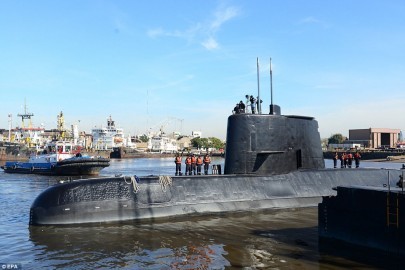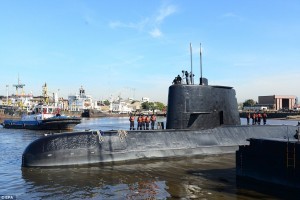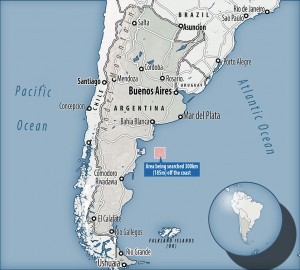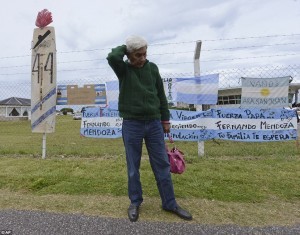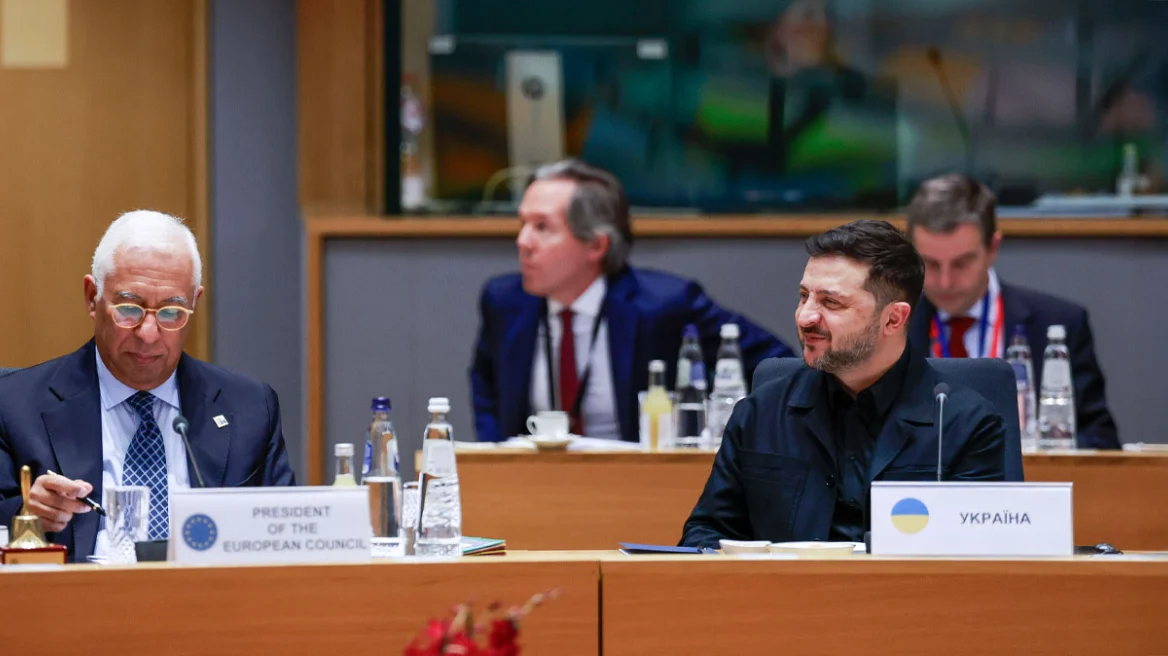The missing Argentine submarine may have been located early this morning, after a US Navy aircraft allegedly detected a ‘heat stain’ from 230ft below the surface, some 185miles from the coast, and rescue vessel reported hearing a sonar signal.
The ARA San Juan was sailing from Ushuaia to Mar del Plata when it disappeared with 44 crew members last Wednesday, including Argentina’s first female submariner Eliana Krawczyk, 35, and Luis Niz, 25, who is due to get married in two weeks time.
The crew’s oxygen supply was due to run out this morning as they only had enough on board to last seven days – leaving the international rescue mission racing against time to the spot where the signals were detected.
Experts, however, said it was possible that the diesel-electric submarine’s oxygen supply might last as many as ten days in the case of a battery failure as reported by the boat’s captain in his last communication.
The Argentine navy’s spokesman, Capt. Enrique Balbi, said yesterday: ‘The seven days is not dogmatic. It varies according to the circumstances.’
Argentine news report that two separate clues to ARA San Juan’s location have been detected.
A US Navy airplane is said to have recorded ‘a “heat stain”, which would correspond to a metal object’, some 186miles off the coast of Puerto Madryn, which could be the ARA San Juan,Clarin.com reports.
The other is a so-called infrasound signal picked up by one of the rescue ships using sonar, the website added.
Families have gathered at the Naval Base in Mar del Plata as they anxiously await news of their loved ones, who have now been missing for a week.
‘We feel anguish. We are reserved but will not lose our hope that they will return,’ Marcela Moyano, wife of machinist Hernan Rodriguez, told television network TN.
‘We’re very worried, we have little news, we’re waiting for communication,’ said Eduardo Krawczyk, father of weapons officer Ms Krawczyk.
‘We can make up a thousand movies with happy and sad endings, but the reality is that the days pass by and not knowing anything kills you,’ Carlos Mendoza, the brother of submarine officer Fernando Ariel Mendoza said.
‘Every minute is oxygen that’s worth gold.’
Many are also taking to social media to express their worries as the search continued into a second week, including Sofi Álvarez, 21, whose brother Luis Niz, 25, is on the ARA San Juan.
She tweeted: ‘We are here, all united, awaiting your arrival, 44 families and a very long wait. Do not stop asking, please, do not lose faith, hope. We are not going to stop until we hug them again.’
‘It does not matter what god you believe in, or what you believe, I only ask that with a prayer, good vibes, good energies ask for the alive appearance of the crew of the Argentine submarine ARA San Juan, one of them my eldest brother. I’m destroyed.’
Speaking to MailOnline, she added: ‘We always talk to him before he leaves port and he did not give us any indication of a breakdown, on the contrary, he told me that in a few days we would see each other.
‘He is about to get married in a few weeks.’
From the Vatican, Argentine Pope Francis said he was making ‘fervent prayers’ for the crew, and prayers have also come from legendary footballer Diego Maradona.
‘I want to send strength and hope to all the relatives of the crew of the ARA San Juan submarine,’ Maradona wrote on his official Instagram account.
‘I think it’s great that we are receiving help from other countries with better technology. And, although I wonder about those responsible for this situation, I think that today the most important thing is to rescue our boys.’
This comes after one of the crew members reportedly warned her family that there had been issues on board, just days before it vanished.
Ms Krawczyk’s brother has since revealed that she called the family before they set off and told them there was a mechanical problem.
Speaking to Argentine radio and newspapers, Roberto Krawczyk has said his sister told him that the submarine had needed repairs while in port.
ARA San Juan was returning to its base in Mar del Plata after a routine mission, and left Ushuaia last Monday. Authorities lost contact with the vessel two days later.
Navy spokesman Enrique Balbi said that if the sub was settled on the surface, or able to put up a snorkel to draw fresh air, there are supplies on board to last for a month.
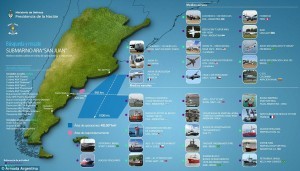
But if the sub is underwater – as seems to be the case after surface searches failed to find it – then there is only enough air inside to last for a week.
The craft has already been missing for seven days, and search areas indicate it is likely in deep water, meaning sending up a snorkel would be problematic.
Several signals have been picked up over the past week, including satellite calls and sounds, but they have all turned out to be either bogus or not from the ARA San Juan.
The last known communications from the sub’s crew were on Wednesday last week. One call reported a routine battery fault, while the details of the second call have not been disclosed by the navy.
A multinational air and sea search is underway with help from countries including Brazil, Britain, Chile, the United States and Uruguay.
Storms, seen in this video, have complicated efforts to find the navy submarine, which had gone missing in the South Atlantic.
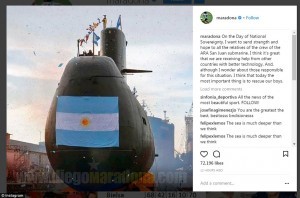
Authorities have mainly been scanning the sea from above, as storms have made the search difficult for boats.
The Royal Navy has deployed an ice patrol ship to help search for the missing submarine.
Britain sent the HSM Protector, a polar exploration vessel, to the southern Argentine Sea to assist in searches.
Britain and Argentina fought a war in 1982 over the Falklands Islands, which are called the Malvinas in Argentina.
A spokesman for the British Navy said: ‘Following a request from the Argentine government, HMS Protector has been deployed to join the search and rescue effort for the ARA San Juan.’
The US Navy ordered its Undersea Rescue Command based in San Diego, California, to deploy to Argentina to support the search for the submarine.
NASA also sent its Antarctic P-3 Poseidon surveillance aircraft.
President Mauricio Macri said in a tweet that the country will use ‘all resources national and international that are necessary to find the submarine’.

The TR-1700 class diesel-electric submarine had been returning from a routine mission to Ushuaia near the southernmost tip of South America, to its base at Mar del Plata, around 240 miles south of Buenos Aires.
The San Juan is one of three submarines in the Argentine fleet.
The 213-foot long submarine was built in 1983 by Germany’s Thyssen Nordseewerke. However, it underwent a seven-year refit between 2007 and 2014 to extend its life by a further 30 years.
The German-built submarine, which uses diesel-electric propulsion, was inaugurated in 1983, making it the newest of the three submarines in the Navy’s fleet, according to the navy.
Source: dailymail.co.uk
Ask me anything
Explore related questions
